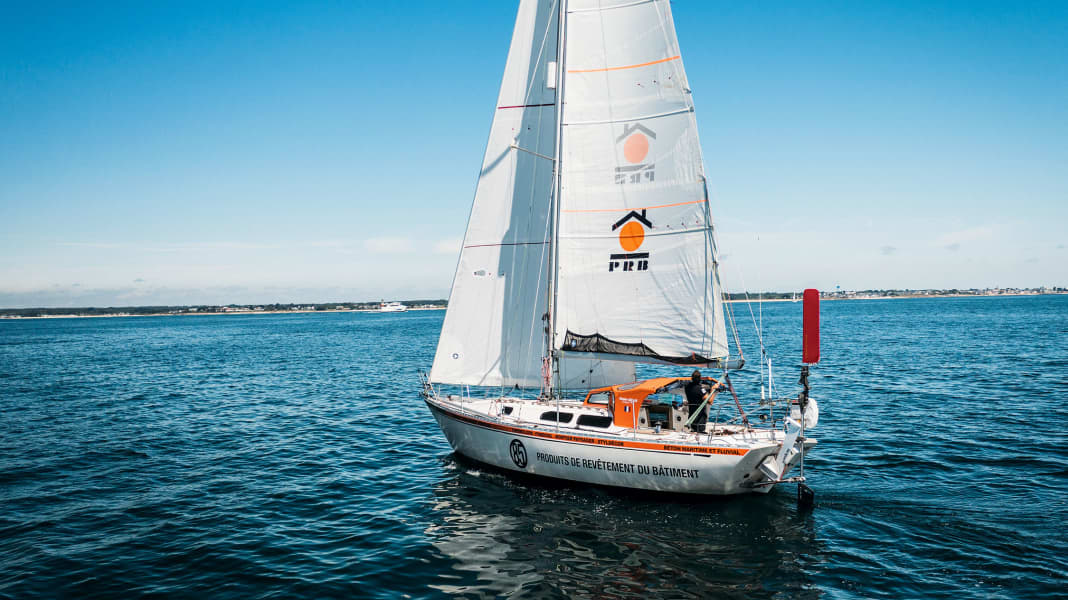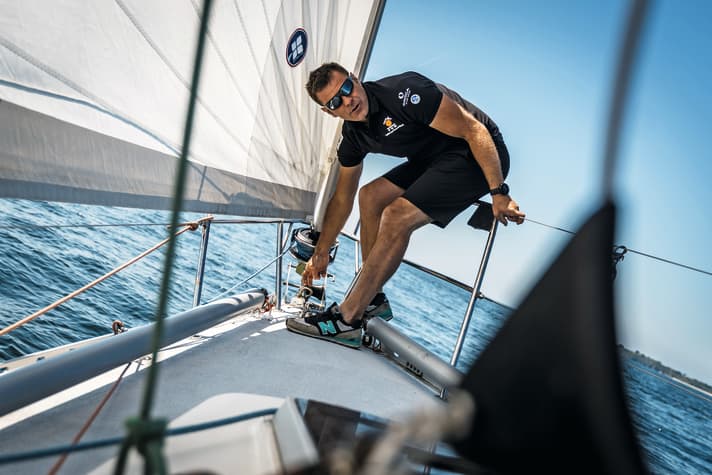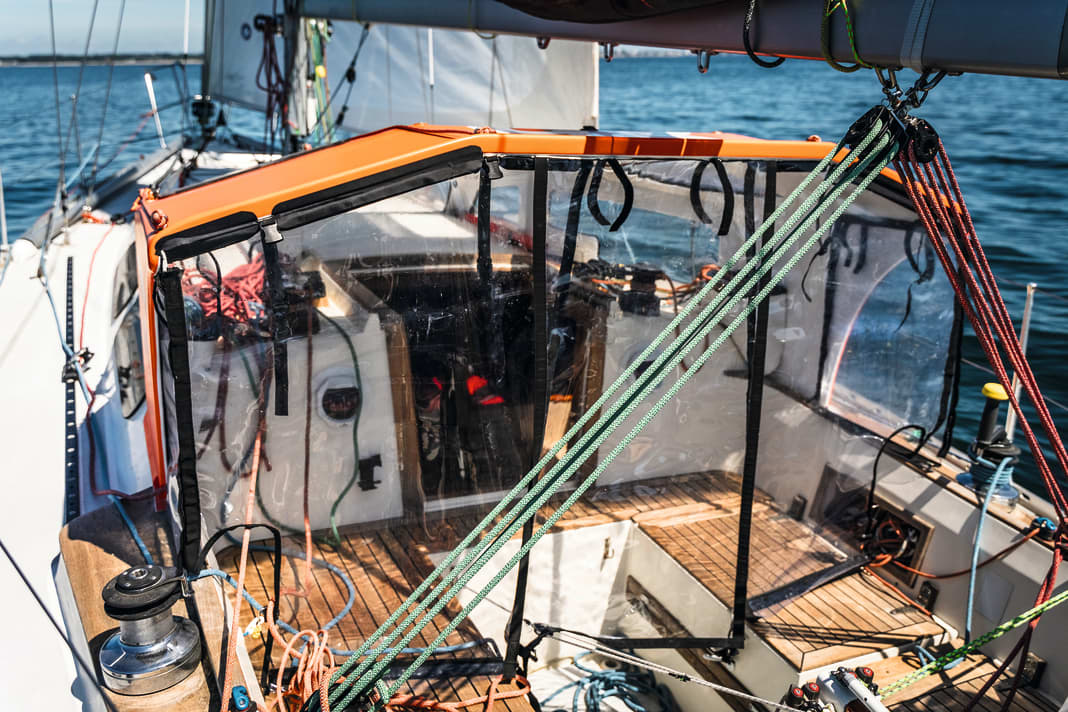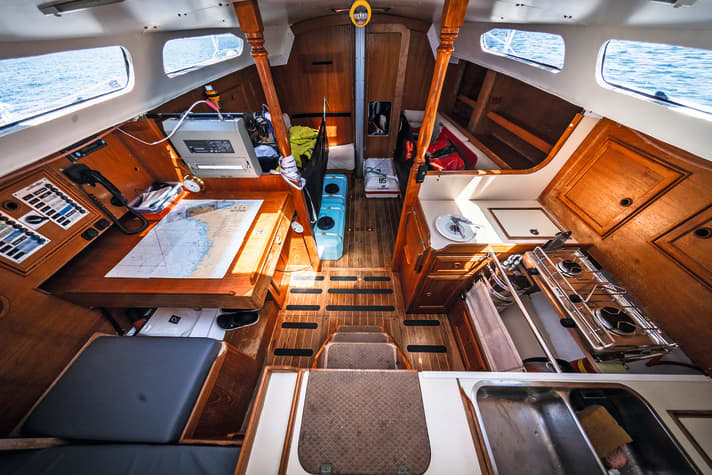
She looks a little out of place. The Rustler 36 from the early 1980s is moored on the outer jetty in the "La Base" regatta harbour in Lorient like a relic from days gone by - like an old man who wants to join the party of the youngsters.
This jetty in Lorient is usually home to the racing cars of the sailing scene. On this Tuesday morning in May, the maxi-tri "Gitana 17" was launched for the first time after its winter break. Sailing star Ian Lipinski is trimming the rigging with his team a few boats away, and the brand new Imoca "PRB" is attracting attention with its futuristic orange-coloured hull. Those scurrying around the harbour are wearing sponsor outfits and work for one of the professional sailing teams based here on the coast. And in the middle of it all is the GRP oldie. But if you take a closer look, you will realise that it too is a tiny part of the sailing mosaic in Lorient and not an exotic cruising yacht that has taken a wrong turn on a cruise. Here too, "PRB" - a French building materials trade - is prominently named on the hull. Here, too, there is much to suggest that its skipper has big plans for it. Really big.
Damien Guillou wants to sail around the world in his 10.80 metre yacht. Alone and non-stop in the Golden Globe Race, which is due to start on 4 September in Les Sables-d'Olonne. A good 20 brave souls from all over the world want to sail around the globe against each other ( Regatta information see below ). They are all driven by the desire for adventure and the hope of a good placing - perhaps even victory - in this round-the-world regatta for amateurs, but also some professionals. Damien Guillou is one of the latter, even if his name is not yet familiar to many. The cheerful 39-year-old with a sun-tanned face earns his living in the French offshore scene. Most recently, he worked as a preparateur for Vendée Globe skipper Kevin Escoffier, who is under contract with the same sponsor. Now Damien is a skipper himself and, with the help of others, prepares a boat for the hussar ride around the globe.

The Rustler was customised to the skipper and route
Today we have a short test sail off the coast in lovely early summer conditions with 20 degrees and eleven knots of wind - if that. Despite it being a weekday, there is a lot of traffic in the fairway off Lorient. Nevertheless, Damien quickly sets the sails and even activates the wind steering system. "It's fine," he says and laughs. He is one of the locals and has known the Bay of Biscay and the Atlantic coast from an early age. He lives in Port-la-Forêt and has transported his boat the 30 nautical miles from there to Lorient for this training day, which he is combining with a meeting with his sponsors. These are not actually the conditions in which he is preparing for the upcoming adventure. In the coming weeks, he wants to set sail in the forecast 40 knots and more and sail to the Bay of Biscay shelf in search of the worst possible conditions. He wants to test whether everything on board will hold up in the stormy seas that prevail there.
Over the past twelve months, the sporty family man has prepared everything, absolutely everything, on the Rustler for exactly this kind of rough-and-tumble sailing, supported by a preparer and sailing friends such as Vincent Riou, who won the Vendée Globe in 2005. For example, there is the dodger above the companionway. The bright orange roof, visible from afar, was adapted to Damien's height of 1.84 metres. Standing in the cockpit, he can look over it, but also work well underneath it. He can see the sails being set and trimmed through windows in the roof. Transparent sheets can be lowered from above to keep the elements out.
To be able to steer from the companionway, the skipper can put a long tube on the tiller. But there is nothing there at the moment. In a patent jibe, the tip of the tiller has broken in front of a fitting. He's glad about that. "I want to find all the weak points in advance!" Of course, the single-handed sailor wants to steer as little as possible himself on the 30,000 nautical miles. He can also adjust the angle of attack of his Hydrovane wind steering system with the help of a line deflection from the stern to the companionway. He has already familiarised himself with his system in this way during his 2,000 nautical mile qualification cruise. He opted for the model on the advice of Jean-Luc Van Den Heede - the winner of the 2018 Golden Globe Race - mainly because it has its own rudder blade, which he could still use to steer if the rudder broke. Damien doesn't want to leave anything to chance: There is a complete replacement on board for the hydrovane, and two for the sextant. "I do what I can."






Damien's highlight: an old tow log
Further special equipment is enthroned at the stern: a hydrogenerator for power generation, an isolator in the backstay for short-wave radio. An active radar reflector is mounted on the railing ("a requirement of the race organisers"), next to it an antenna for the weather fax. Underneath is Damien's highlight, an old towed log. He found it on board after buying it and fitted it. If he now throws the tiny propeller aft on a thin line, the analogue display shows the speed and logged distance. At least in theory. "The speed isn't right, but the distance display is," says the sailor happily. GPS navigation will be taboo on the trip around the world, as will many other conveniences on modern yachts. Damien has ten spare lines for the tow log with him. He had the small propeller replicated as a 3D model and manufactured by a specialised company. "My navigation wouldn't work without this part," he says.
The rig was also prepared for all eventualities - the mast, boom and standing rigging are new. Unlike Van Den Heede, he has not opted for a shorter mast. "It's still a race! We have taken other measures." For example, the mast is no longer on deck, but is now set on the keel. And there are two pairs of spreaders instead of just one. Rivets along the mast profile indicate an additional, internal profile that reinforces the mast. "If I capsize, this should prevent it from breaking in the lower section," says Damien.
On the Rustler there is a fixed forestay with furling system, a second, removable forestay and a third, also removable, for the storm jib. All the sails are stacked in bags in the forward cabin. The Frenchman has completely gutted the cabin and can now climb down from the outside using a ladder. It can be accessed from the saloon through a watertight door. There is an anchor at the very front - just in case. If everything goes well, he won't need it. Even on the obligatory media stops in Cape Town, Tasmania and Uruguay, an anchor manoeuvre is not planned. Just a quick sail down, interviews, then onwards. The solo sailor will sleep in the dog bunk on the port side behind the navigation station. There are straps here that he can use to buckle himself in. "A requirement of the organiser," explains Damien. "I don't know yet whether I'll actually do it." Instead, he has replaced the mattress with a quick-drying one.
A bag of food is packed for each day
Leech sails will be permanently hoisted in front of the saloon berths. Equipment, spare parts and provisions are stored there in packed waterproof bags. Only light items are to be stored in the lockers. Additional water canisters are lashed to the floor - and the life raft. "Some people prefer to attach them to the deck," says Damien. But in the event of capsizing, it could be swept away by the water. You won't find a saloon table - what's it for? Damien wants to cater for about 230 days in advance. Here, too, he leaves nothing to chance. Months before the regatta, freeze-dried food is already on his menu in order to find products that he likes. He has already discovered instant chocolate mousse for himself. Tinned fruit comes on board as a dessert and motivational kick for bad days.
To keep track of how much he is allowed to eat, a bag of food is packed for each day, which in turn is stored in monthly boxes. The provisions will probably last longer than planned. Because: "I know that there will be days with storms down there when you're not feeling well and you won't be able to cook or eat much." Mashed potatoes, rice and noodles are brought on board as a change from bagged food. To save water, he wants to cook them with one third fresh water and two thirds salt water. "Not having enough to eat would be bad. Not having enough to drink would be a disaster," he says. Yet that's exactly what happened to some sailors in the last Golden Globe Race.
Not having enough to eat would be bad. Not having enough to drink would be a disaster!
On departure, 600 litres of fresh water should be on board the "PRB": 220 litres in the permanently installed tank, which is preceded by a smaller tank with a filter. This way, he wants to make sure he doesn't drink any contaminated water. Two large plastic tanks of 60 litres each are lashed to the saloon floor of the Rustler. The Frenchman wants to take the remaining 260 litres with him in canisters. As he reckons on three litres per day, this would be enough for 200 days. He doesn't actually want to be on the road any longer than that. If necessary, however, he could replenish his supplies using his ingenious rain collection system on the mainsail. "If I run out, I won't cook rice or pasta," he explains. There is a pump for seawater at the sink to wash up And how will he wash himself? Damien looks mischievous. "Well, it's not really necessary where we sail slowly." And, after all, he is alone on board.
Dozens of modifications to the Rustler 36
To sit safely while eating, he can pull out a board from behind the companionway and place it on a step. Placed on this child's seat-like construction, the Frenchman can hold on to the saloon supports on the right and left. A fold-out board on the galley serves as a mini table. This is just one of the dozens of modifications that Damien has come up with to make life on board and racing on the eleven metre boat as bearable and successful as possible. To achieve this, most of the things that once provided comfort on the Rustler had to go: as the forepeak had to give way to the wet room, toilet and washbasin in addition to the berth, the toothbrush, toothpaste and a small mirror are now on the wall above the washbasin in the galley. That will have to do. The design of the navigation corner also speaks volumes: a map of the Bay of Biscay lies on the navigation table under the weather fax machine, while the table contains the utensils for astronavigation. Damien was good at this after practising hour after hour with an instructor last year. "But after the months in the shipyard, I've forgotten a lot," he regrets. However, there is still time to refresh his knowledge.
If you look behind the control panel, you realise that not everything is the same as it was 50 years ago - for safety reasons. This is where the AIS transmitter for locating the boats is located. Damien and his team have also modernised the electrics - as a precaution. What is completely missing on board is a personal touch. No picture of single-handed pioneer Joshua Slocum on the bulkhead, no scribbles from his one-and-a-half-year-old daughter or four-year-old son. Not even photos. Later, after his return, he wants to go sailing with his family on his own catamaran. Around the Atlantic for a year - not around the world in nine months.
This trip could certainly be dangerous, Damien admits. But you also get into the car, which is also a risk. "That's exactly what I try to minimise through my meticulous preparation," he explains. So does the professional fear anything at all? Loneliness? Accident? Loss of mast and keel? Losing? An unhappy sponsor? Damien smiles: "What really annoys me is my compass! This swinging in five-degree increments drives me crazy!" Coming from the world of imocas, he is used to digital displays, accurate down to the decimal place.

More than a third of the Golden Globe Race rides Rustler
That won't stop him from achieving his goal: "I want to win," he says. With powerful sponsors behind him, such as PRB for the boat and equipment or North Sails Performance for his offshore oiler, Guillou is definitely one of the favourites. His sponsor bought the Rustler in Venice for 75,000 euros. At least the same amount was spent on equipment and refit, more likely more. The British Rustler shipyard has built 126 of these boats since 1980. Even today, at the customer's request. Jean-Luc Van Den Heede's victory in the 2018/19 Golden Globe Race on the "Matmut" means that this type of boat is now one of the most sought-after for the world regatta. As of the end of June, eight skippers want to compete with it in the autumn. That's more than a third of the fleet.
However, not everyone will make it to the starting line. Some have already given up - the hurdles to getting the ship ready in time are sometimes too high. Covid, supply bottlenecks - all of this is also keeping the non-stop sailors busy. Some simply run out of money on the home straight. For Damien Guillou, on the other hand, everything has gone according to plan so far. Is he already thinking about the time after the circumnavigation? His next sporting goal - perhaps a regatta on one of the modern speedsters around him? "We'll see," he says evasively. "For now, I'm fully focussed on the Golden Globe!" He feels fit for the endurance test - and his boat seems to be too.
Technical data: Rustler 36
- Designer:Holman & Pye
- Shipyard: Rustler Yachts Ltd
- Total length:10,77 m
- Waterline length: 8,21 m
- Width:3,35 m
- Depth: 1,67 m
- Weight/ballast: 7.6 t/3.4 t
- Sail area on the wind: 67 m²
- Sail carrying capacity: 4,2


Golden Globe Race: retro around the world
In 1968, nine sailors competed against each other in the first round-the-world regatta, the Sunday Times Golden Globe Race. Only one of them made sailing history: Sir Robin Knox-Johnston. 50 years later, in July 2018, 17 skippers took part in the revival of the race. On long-keelers designed before 1988, they sailed around the world on the same route as back then, using the navigation equipment of yesteryear. No electronic aids were permitted on board; the skippers navigated in the traditional way using a sextant and paper chart. The new edition of the race is to be repeated every four years in future. The next start is on 4 September in Les Sables-d'Olonne. All information about the race can be found here >>

